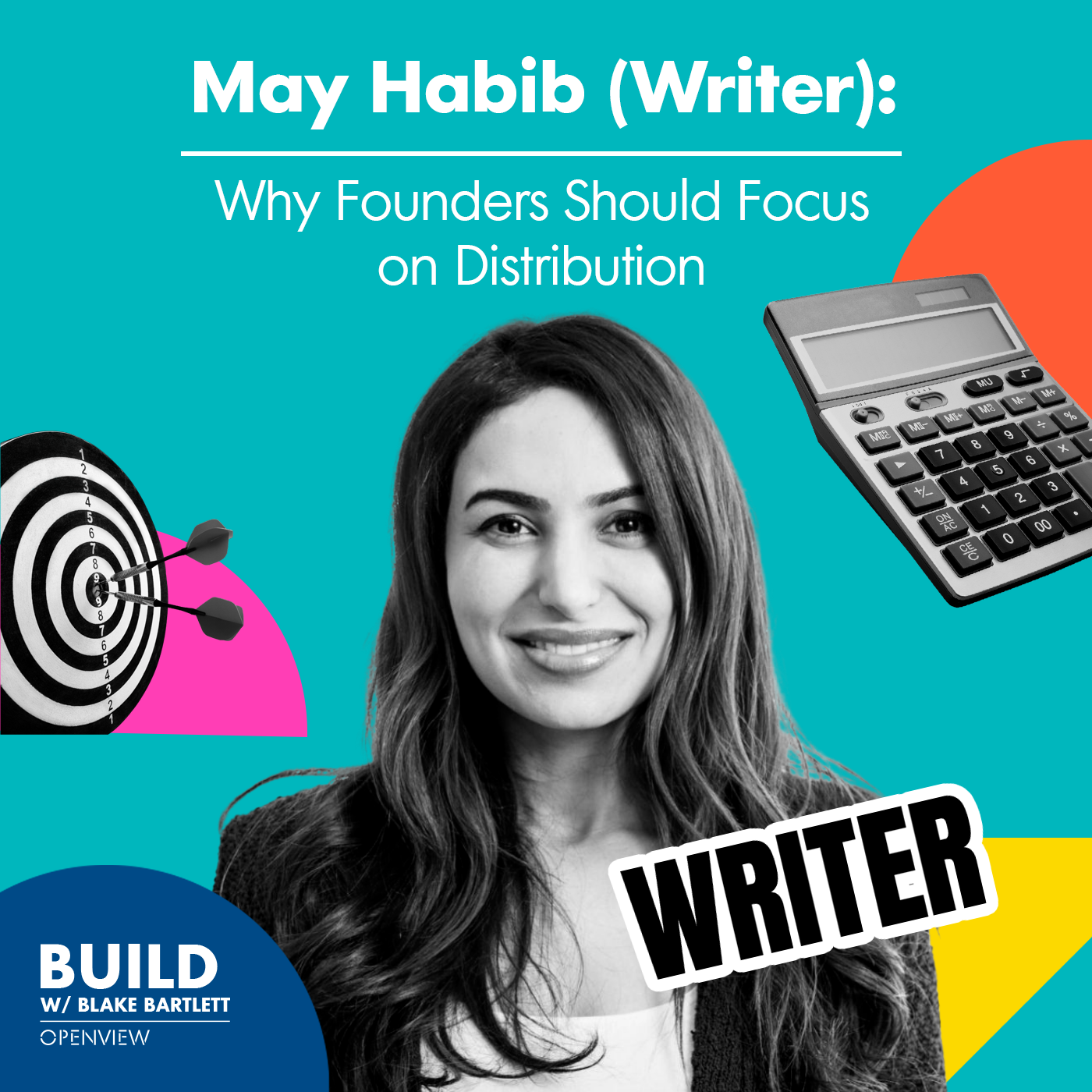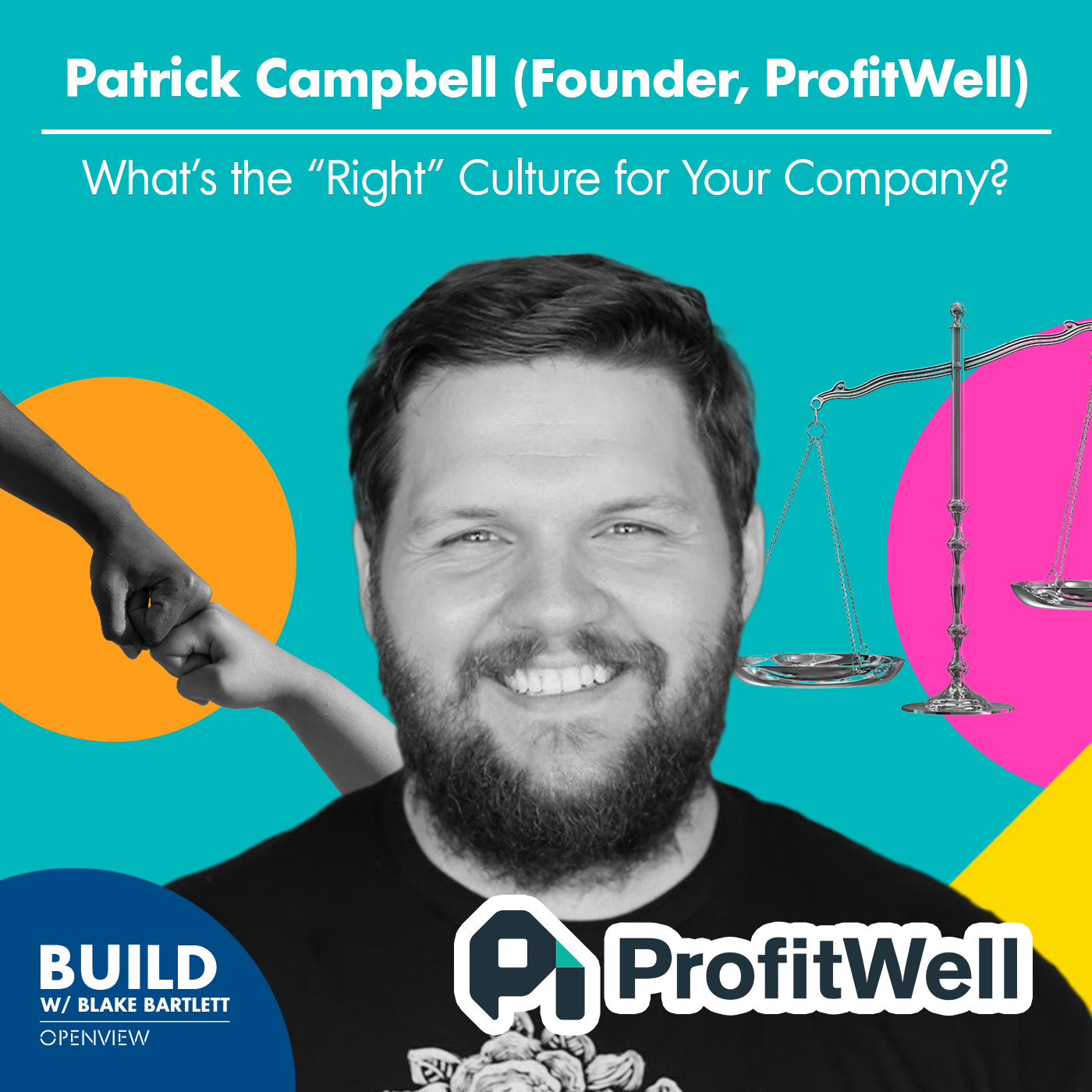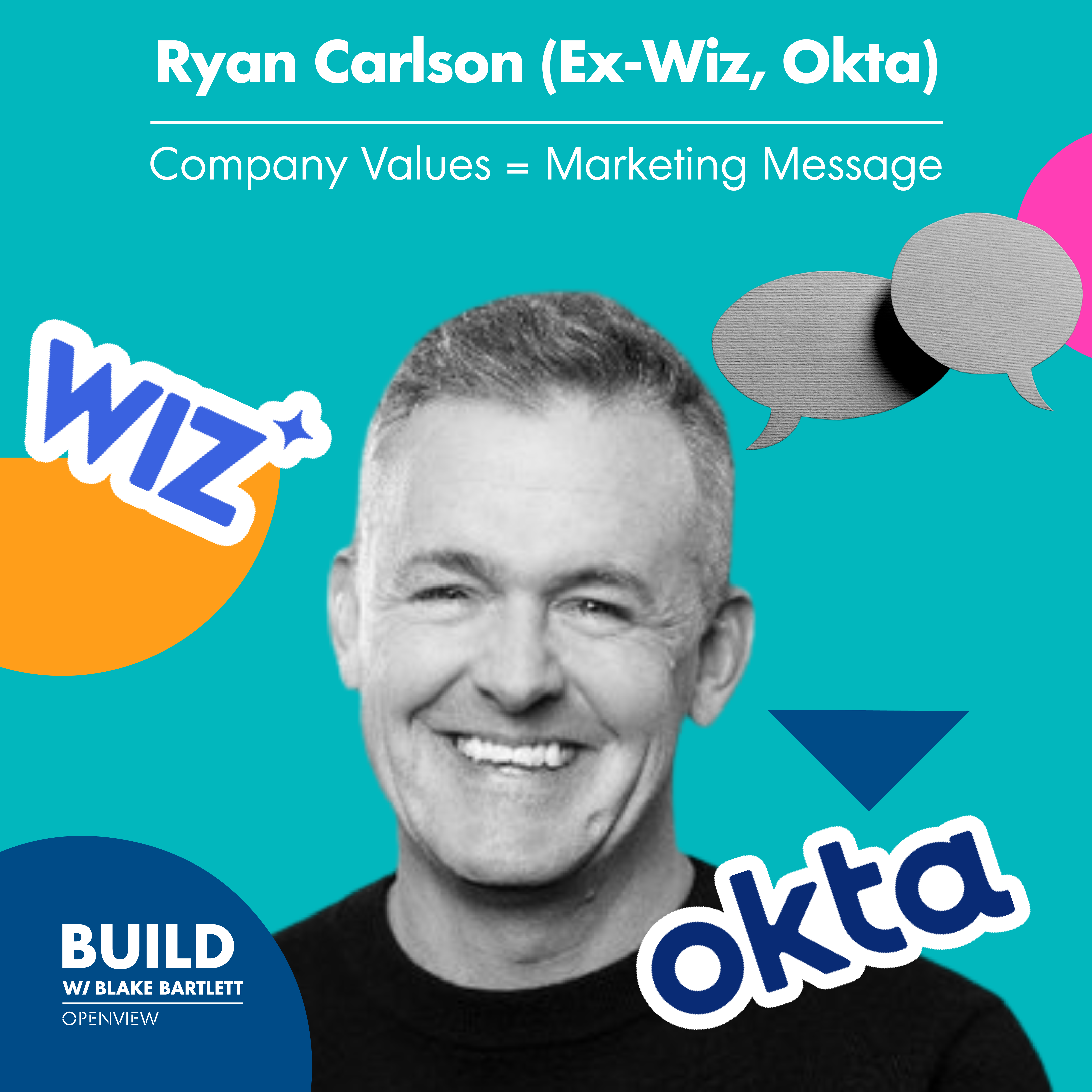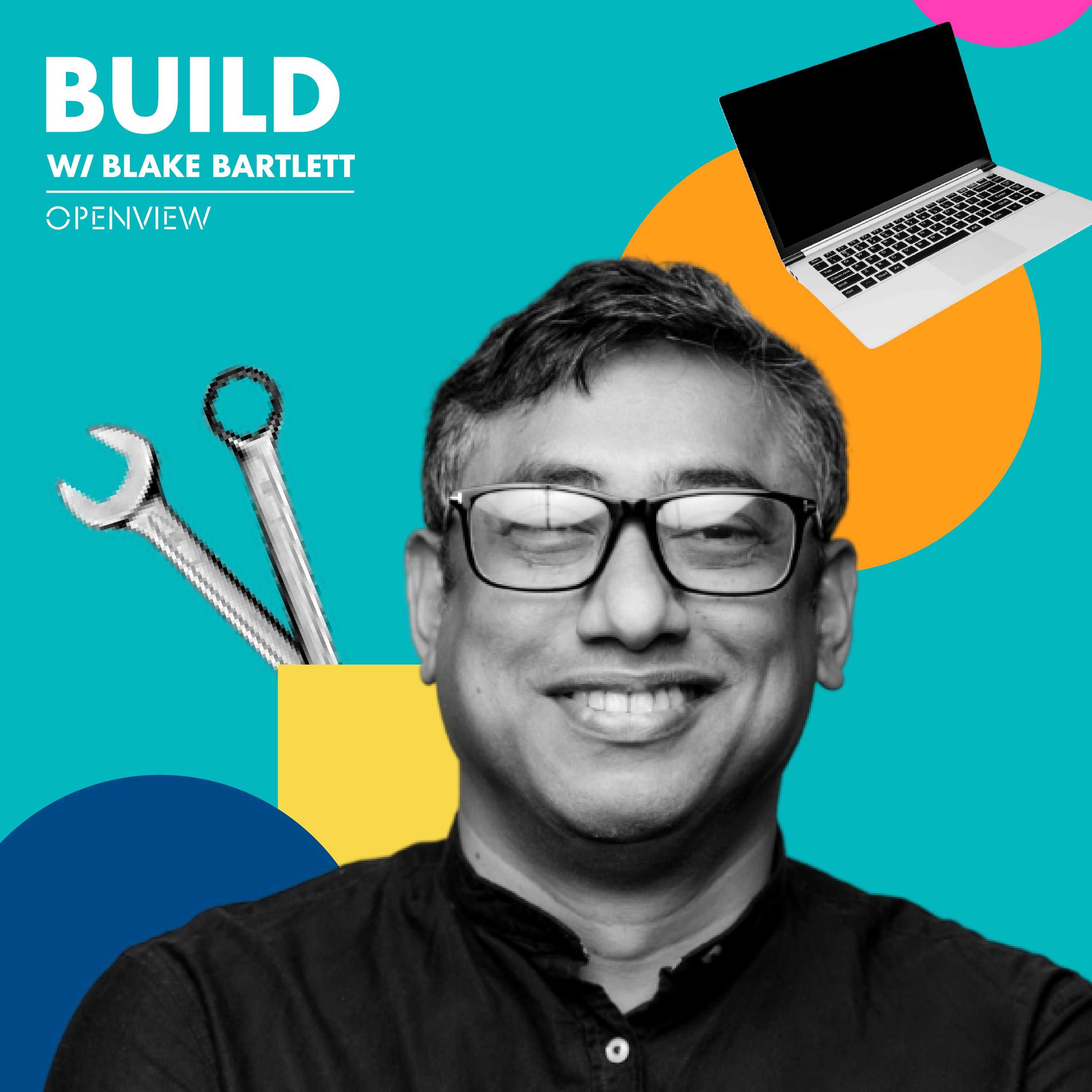May Habib (Writer): Why Founders Should Focus on Distribution
- 0.5
- 1
- 1.25
- 1.5
- 1.75
- 2
May Habib: ...but from what I've read. I think once you've had the experience of building something people want, you've got that muscle, you've got that confidence, the second time around, you're a bit more ambitious and you're thinking," How can I build something people want and how can I get it into their hands that much faster?"
Blake Bartlett: Welcome to BUILD the podcast from OpenView. I'm your host Blake Bartlett, and the show features conversations with software founders, leaders, and investors. Each episode unpacks a new key insight on how to build your company and navigate the fast changing world of software startups. Today's conversation with May Habib totally opened my eyes to a new founder superpower: product distribution. May is the co-founder and CEO of Writer, the AI writing assistant for teams to help you write more consistently and effectively across a large team. Writer is a super cool product with great PLG distribution. So May is definitely the right person for today's topic. Okay. So back to how May changed my perspective on founder superpowers. She argues that it's common for founders to obsess over product, and there can be this belief that if you build a truly great product, everything else will just figure itself out. I think any founder who's actually built something will tell you this is clearly wrong. Yes, you do need to obsess over product, but then you need to focus just as much on distributing that product so all those potential customers out there can become actual customers who use and love that wonderful product you put so much time and effort into. May walks us through her approach to distribution, and also the downstream implication for things like assessing product-market fit and identifying the most important metrics to track as a distribution obsessed founder. All that and more on this episode of BUILD, so let's dive in with May Habib. So today we're going to be talking about different things that you can focus on and what to prioritize as a founder, and specifically looking at product versus distribution. So Justin Kan had a great tweet back in 2018, which said that first time founders are obsessed with product, but second time founders are obsessed with distribution. What does this mean to you?
May Habib: So I guess when he said that I was definitely a first time founder then. Now I am a second time founder. I think distribution is actually a broad term. And I have realized that we've actually broken down what distribution is into three parts. And the first part of distribution is how people find your product. The second part of distribution is how they get to value, like mechanically, what are the steps they need to take to use it. And then the third part of distribution is how do users tell other people about your product? How do you get that adjacent user? And that's all distribution actually. And I think once you've had... And this is what I think Justin was getting to. I don't know him but from what I've read. I think once you've had the experience of building something people want, you've got that muscle, you've got that confidence, the second time around, you're a bit more ambitious and you're thinking," How can I build something people want and how can I get it into their hands that much faster?" So Justin is a repeat entrepreneur. So I'm thinking that's what he meant. But from reading about him shutting down Atrium, it doesn't seem like he shut it down because of distribution and it was more because inaudible at economics. But my guess is he would've thought about distribution before they even wrote code. So yeah, that definitely rings true, but I would break it down even further. And yeah, absolutely. I mean, from first principles with Writer, we have been thinking about how we get this into people's hands really fast.
Blake Bartlett: So if we start with the first part of that, what does it look like to be obsessed with product? And why is that maybe a first time founder thing versus a second time founder thing?
May Habib: Obsession is a great word. There's so much there. I think it's like what you think about before you go to bed, what you think about when you get up. And practically at Writer, it's meant, for us, product and go-to-market together. And I think being obsessed with product the first time around is," Does this thing work?" And I think the second time around is," Does it work and will I be able to get it into people's hands?" And to back up for a sec, because understanding what we do and why I think it's important for understanding how we think about distribution, Writer is an AI writing assistant built ground up for the needs of businesses. And what that means is everything from the data we use to train our models, it's the stuff we write at work, the way we taxonomize what writing even is, it's based on the way modern companies are structured from marketing the sales to product to support, we are security and privacy first, which means unlike other tools, we don't use any customer data to train models. We don't even save it down. So the big insight that drove us is that writing really is that last unsystemized major business process. And our goal at Writer is that when people are looking at a page, whether it's to write a health article or a piece of collateral, there's actually a tremendous amount of intelligence behind the cursor in terms of what the company wants you to say, what you and your colleagues have written before, what will impact your users. And so with that being the vision, we can kind of work backwards to get broad distribution for a product like this. And we thought about those three principles. How will people find us? How will they get value? And then, how will they tell others? Given that is what we want to do, professional writing, assistant for work, we were really able to get obsessed with product and go-to-market together working backwards. I think the important thing is like, where is the focus of the obsession and your capacity grows. And so as a second time founder, and so I do think you're just able to get product built and shipped faster and better, but like, what are you thinking about before you go to bed? What are you thinking about when you wake up? Like, for us it is distribution. It is growth. So yeah. I love that quote.
Blake Bartlett: Yeah. It reminds me of... I had a conversation actually on the BUILD podcast with Chris Miller, who's a VP of Growth at HubSpot. And he was walking me-
May Habib: Yeah. I love Chris.
Blake Bartlett: Yeah, he's great. He was walking me through his definition of adoption because I think a lot of folks it's really easy to say," Let's focus on product adoption. We got to get our product adoption up." But he really unpacks that and says," Well, adoption is not a single thing. Adoption is actually two things. It's acquisition plus activation. And both of those together create an adopted product."
May Habib: Yeah.
Blake Bartlett: And so that's again kind of parallel to this idea of you have to build the product, but then you have to distribute it, and then folks actually have to use it. So I guess that kind of brings up the idea of jobs-to-be-done a little bit to me. What do you think the role of jobs-to-be-done is in this framework of product versus distribution or product plus distribution?
May Habib: Yeah. I love the jobs-to-be-done framework. Like, people aren't buying a drill. They really want a hole, right? And they're buying a drill to get the hole.
Blake Bartlett: Yeah.
May Habib: And especially if you are PLG and you want to build an inbound engine that's driven organically and by SEO, you've got to think about jobs-to-be-done first because if you're not thinking about the problem you're solving through the words and the lens that your users are looking for your product or a thing that solves their problem as your product does, then you're just going to get it wrong. So I love jobs-to-be-done. So many of these frameworks, like, you can just over framework your life. But I do think that what's nice about jobs-to-be-done is, to me, it's like the drill versus hole. That is like the perfect way to analyze it. People don't want an AI writing assistant. They want better writing. Now it just so happens that in our market there is this massive player that has spent a lot of money to educate the market on what an AI writing assistant is. So that is something that the audience already knows, but that's just a quirk of the market we are in. You really have to understand how your specific audience, your specific users think about the problem, the words that they use, because that is going to feed into all of the acquisition you do.
Blake Bartlett: So let me pull all this together and test something with you. So through the lens of Writer, which obviously is intended to improve people's writing in the professional environment, if you were merely focused on product or merely obsessed with product, that could take you down a path of," Well, if we want to improve people's writing, where do they write? They write in a word processor, maybe let's build a new word processor. Let's build a new Microsoft Word. Let's embed sort of intelligence into it. And let's make folks better writers that way." You could reach that conclusion. And maybe you could build the best word processor in the world with all this AI embedded into it, but then you go and launch it and nobody wants to adopt a new word processor. So you're sort of then stuck. So you might have been focused on product, built an amazing product, and it totally will get the job done, but nobody's using it because nobody wants to switch off of Word or switch off of Google Docs for example. So looking at it through the lens of jobs-to-be-done and distribution, let's not build a word processor. Let's build something that wherever you're writing, we bring that intelligence, we bring that AI writing assistance in, and that's sort of something that folks will then adopt. It doesn't require the switching cost for something that's a core system that they use. And that is what being distribution minded can look like while you still are solving the same problem.
May Habib: Yeah. Absolutely.
Blake Bartlett: How does that land? Does that make sense?
May Habib: That's perfect. And those are actual conversations we had early on in the life of the company. So you absolutely nailed it. And I think that in our case, it's so explicit and tangible being everywhere versus being in one place. So not every early stage company is going to have that perfect analogy, but yeah, being able to focus on being where people are for us is distribution. Now, in our business, given that we are an AI writing assistant for professionals, there's a part of the distribution thinking that takes a lot of product and time that does doesn't really show up in the front end. And that's the stuff around... You know? To distribute in highly secure environments, there's all sorts of things that need to happen in how you integrate with Google workplace, now it's called Microsoft Office Suites, Enterprise Microsoft environments. And so distribution for your audience is going to mean something different. And at Writer, it definitely means like that invisible enterprisey part around being able to get 10,000 users at United Healthcare and know our web app well. Like, there's a distribution mechanism for that. And we've had to think about that bottoms up.
Blake Bartlett: So let's talk about what it looks like. We're sort of in the abstract theoretical world right now. So let's bring it down to the ground level. What does it look like to be obsessed with distribution in real life? How does this take shape at Writer for example? I know you mentioned that being obsessed with distribution is making it easy for somebody to find the product, to get value out of the product, and then to tell other people about the product as well. So maybe through that lens, what does this look like day-to-day at Writer? What are some of the decisions you've had to make?
May Habib: Yep. Early on, it was actually pretty tough to find very practical advice on this. I'd love to be as detailed as possible to help folks who are early stage listening. In my previous company, we had one or two KPIs per team, and that basically worked. In a distribution focused world, it's actually a much longer shortlist of metrics that should all move together if shit is working. And it's not rocket science, but I do think it's helpful to hear what we do. And that has been collated from talking to a lot of other successful entrepreneurs on what they did in the early stage. So for us, it is overall traffic, visit to trial, trial to activated, activated to paid, by acquisition channel, and then DAUs in churn that way too. And it's much more holistic and much more integrated than in a non PLG business. So all of our experiments and work is evaluated against that whole funnel. If we had 2, 000 Chrome extension installs, but they didn't become active users, or if we improved visit to trial, but it tanked the Chrome extension install rate, which is for us key to distribution, then those were failed experiments. And so the whole team is looking at the same set of metrics that should all move together versus different leaders have got different things they're trying to optimize in a vacuum. And that sounds very binary too. I mean, most people aren't trying to do it at a vacuum, but when you're distribution focused, when shit's working, it should all work together. Now, if we double traffic and improve the trial conversion, like, that was a good experiment, whatever we did. We should be doing more of that. So we've got targets down the whole funnel. And the goal week over week is to move all the numbers together. I think you all did a really great job publishing some of the benchmarks and for PLG. And so if you're listening and haven't looked up Blake and Kyle's work on that, you definitely should because it's really excellent. So that's really, I think, what being obsessed with distribution means. Like, are you growing your top of funnel? And then, are they doing what they need to be doing in the product? And then, are they telling people about it? And that's all moving and improving together. You've got those elements of distribution going.
Blake Bartlett: So I like this way of thinking holistically about it. It's not just," Did we get one particular metric to go up?" And a lot of folks like to use the word vanity metrics, but it's usually used to discount what your competitor is doing. And then it's never really sort of... You never shine the light in yourself and say," Where are the vanity metrics in my business?"
May Habib: Yeah.
Blake Bartlett: And they're probably everywhere. But this idea of not having a single or a couple of vanity metrics, but really having all of the metrics, but all of the metrics that tell you," Is the job being done? Do folks care about the product? Are they using the product?" And so it kind of brings in, what I'm hearing from you, is that it brings in the funnel metrics. You know? You talked about traffic and then visit to trial, trial to install. So you're thinking about those things. But then you're also, which are, again, funnel metrics, are folks progressing through the user journey at the beginning phases. But then you're also looking at engagement metrics thereafter. You know? DAUs for example. Are they continuing to use it? And is it engaging on that front? So that kind of brings in that holistic lens. Is that the way you think about it?
May Habib: Yeah, absolutely. Good summary.
Blake Bartlett: Is there still a role then, I guess, for bringing back vanity metrics? But the good flavor, I do believe there's a lot of value in a north star metric, sort of a principle metric that's sort of if you only have one, it's kind of the Pareto principle, it guides all of the others. What do you think about that? Is there a role for a north star metric or does this holistic system sort of replace that?
May Habib: Yeah. I wouldn't say if you could only choose one because I think that's the same thing as saying there's only one. And so we don't do north star, but we do have this concept of first among equals and that is DAUs. If we have off the charts DAUs, but a user base that's not growing, that's not inviting, well, that's telling us something about our go-to-market and our product-market fit. So DAUs is definitely first among equals, but it is in the context of a healthy growing business.
Blake Bartlett: So how does this focus on distribution, perhaps, I guess, how you think about distribution, what you prioritize, this holistic view? How does this differ from how you thought about distribution as a first-time founder? Were there things that you emphasized back then that you thought were all important that you might not now?
May Habib: Yeah. We were an outbound based business. And first off, I definitely want to say that I don't think there is any shame in using sales and product experts to help customers see the vision of what your product can do for them, even superhuman on boards one-on-one for a$ 300 ACV. Right? So I'm not here talking about using money to scale a team or scale a go-to-market and using people to tell the customers a story of what their world could look like. I'm really talking about the early days, getting to product-market fit without spend and without the" value selling." I do think that is very important to get to product-market fit without that. In a previous life, that wasn't the case. We got there with outbound. And I think I was just much more focused on the building ARR brick by brick. And I think now I've really internalized, just like... It's very hard for humans to understand exponential growth in any field actually. Like, in our bones, we're not built for exponential anything. So I do think it's a learning process. But now, that is the goal. And so, no one's hung up on one customer, but we certainly are very hung up on users. And that's the big shift, I think customer versus user, from an outbound based business to a PLG business.
Blake Bartlett: So does that mean that in an outbound based business previously you might have been more focused on the SDR team and SDR metrics and are we getting enough outbound calls in and in those types of things versus some of these funnel metrics?
May Habib: Yeah, absolutely. Right? I mean, now it is a hundred percent automated top of funnel. We have one salesperson. And again, there's no shame. We will definitely add salespeople, but it'll look a lot different than what it was before. Now, everyone is in the product from day zero. They've been using the product for months by the time someone in sales is talking to them unless they've expressly put their hand up. So I do think just the way people use and adopt products is changing everywhere. Like, we're talking Accenture by software like this now. This is not like an SMB or VSMB type of motion.
Blake Bartlett: It sounds to me like lot of this lands on, and even that last point about SDRs and things like that, there's a role for them, but perhaps it's not just the volume at all cost role that we were used to from a prior era, that a lot of this really points to a continued evolution that emphasizes activity or emphasizes impact over activity. Because I do think that it's really easy to put metrics against things that are activities. And take SDRs for example. Are you making enough dials? If not, then dial more. Let's get our dials up. Let's get our connect rate up. Like, all of that stuff. Like, this is a lot of lingo that people talked about almost exclusively when we were talking about SaaS distribution a few years back.
May Habib: Yeah.
Blake Bartlett: Now, that's not the first conversation you have when you're talking about top of funnel because that is just merely an activity. It's an input, and maybe it's a good input, but it's also not necessarily the thing that is the ultimate impact you're looking for, which is people using the product, people getting value out of the product, and like you said, people then telling others about the product as well. So this shift is really a shift towards," So what? What is the impact? What did it do at the bottom of the funnel, not just the input at the top of the funnel?"
May Habib: Yeah, exactly. Look. I mean, it's still very much alive. Right? And you kind of read about all of these fast growth businesses. And then the truth is in your inbox, right? Like, how many other CEOs have eight SDR emails that are kind of shitty from a very fast growing, quickly minted FinTech unicorn that shall not be named, that rhymes with lamp. So clearly, people are doing it and it's accelerating their businesses. How long it sustainable for and whether it helps you build the hundred billion dollar dream, that I think I'm more skeptical about.
Blake Bartlett: So in closing, let's bring this to product-market fit. So through the lens of being obsessed with distribution and a lot of things we've talked about, impact over activity, thinking holistically about metrics versus just a single vanity metric, how does all of this connect to product-market fit? And when do you know you have it? What was it like for you at Writer? Any thoughts and reflections here?
May Habib: Yeah. To be philosophical for just a second, I think when you're as privileged as we are and you got your basic needs met on every dimension, I don't think there could be a more interested game to play on this planet than getting to product-market fit with a team of people you respect and love. I ran in high school, which is sort of a team sport because it meets and stuff, but it's kind of solitary. My brothers played soccer and basketball. And I now feel what I'd been missing out on all those years. So, all to say that the journey to product-market fit is incredibly hard, but if you can approach it like you're on a battlefield in a video game, then I think you can really separate yourself from the game you're playing and you'll get better at the game faster if you do. And that was kind of my big realization. So we spent the last 18 months or so getting to product-market fit. And now, our next stage is about growth, which is awesome. I think that's the second most interesting game on the planet you could be playing. And I am very excited about this phase too. But your question was about PMF and I think there's probably three iconic pieces written about this, and I'd be surprised if your pre-PMF audience doesn't have them memorized already. But one is the classic Ben Horowitz thing from The Hard Thing About Hard Things. You know? The money is stacking up faster than what to do with it, et cetera. But the reality is that wasn't really fine grained enough for most of us. Right? It's still not very specific. I think the next iconic thing was Rahul's paper and it was pretty academic. So I think I'm good calling it a paper on the First Round blog. And I think the latest edition, and this is what really helped us, was from Lenny. And he's got a product-market fit piece, but I think it's pretty general. His gold piece, I think, is," What is good retention?" So much of the knowledge on getting from zero to one is in the minds of the people that were there. And the reality is that a lot of the people we associate with breakout successes were the people that were there, one, knew a hundred, not zero to one. Those people are probably too fucking tired to write or do podcasts. But it doesn't matter, right? The knowledge is out there and it's in this great piece, thanks to go-to-market folks who are transparent and generous in sharing these metrics on what enabled these companies to go one to a hundred. So I guess you could see I'm showing my hand a little already in terms of like, for us, product-market fit was about, is about user and dollar retention. You should definitely be tracking things separately because you don't want business model or pricing, which may or may not be directionally correct to be clouding whether you have product-market fit or not. So for us product-market fit looked like something on paper and that was really based on us benchmarking the market. What did best in class look like? Here's what our metrics based on our distribution strategy looked like. And like, how are we doing? And that was the paper piece. And then the in our bones piece, it felt like customers and users telling us about how much they loved using Writer, going on camera to tell us how much they loved using Writer, which is huge, inbound and trial starts based on word of mouth. I was really influenced maybe a year and a half ago. The Asana CMO on some podcast said," Public company, 25% of their top of funnel is word of mouth." And I was just like," Yes. Duh." And so that just felt really good. The other piece was just this long tail of micro, micro feature requests. And in Saas, that's amazing because it means you've become the source of truth for a whole set of processes, and customers really want to help you complete that product journey. So that all started happening at once, which is awesome. We don't spend any money on marketing. Zero. We only have one person in sales. And that was a lot very intentional. Let's nail it before we scale it. So yeah. And now we're scaling it. So we are hiring for every job imaginable. The JDs haven't even been written yet. So folks listening who want a great gig, hit me up. I'm May at Writer. But yeah. That has been kind of our product-market fit journey, Blake, and lots of things out there to help and lots of dark days too when nothing seems to help, but then you find the light at the end of the tunnel. It's awesome.
Blake Bartlett: Well, what I'm hearing from that is a lot of folks oftentimes are looking for the single magical definition of product-market fit. Give me that one sentence or give me that one magical equation that's super simple and they'll just know it for all time that I've arrived at product-market fit and that is not how it works. And it sort of brings back to the consistent theme of this conversation, which is really looking at things from the holistic standpoint, not just," Did I hit one particular metric that told me that I had product-market fit," but everywhere you look in your business from the metrics to the micro feature requests, to people telling you how much they love your product and everything in between, all of that together in concert tells you you have product-market fit. It's almost a sense you get rather than sort of a number that turns green on a page one day magically.
May Habib: Yeah, exactly.
Blake Bartlett: Well, May, this has been fantastic. Thank you so much for joining us here on the BUILD podcast to walk us through your journey as a first time founder going into a second time founder and this idea of being obsessed or focused on product versus distribution and bringing things full circle. So thank you so much.
May Habib: Awesome. Thanks, Blake. Thanks for having me.
Blake Bartlett: Thanks for checking out BUILD. If you enjoyed the conversation today, make sure to subscribe on your favorite podcast platform and leave us a review so that others can find the show as well.
DESCRIPTION
Founders often obsess over product, and for good reason. It’s hard to have a good business with a terrible product. May Habib argues that is only half the solution for founders. It’s equally important to obsess over product distribution. After all, it’s hard to achieve and maintain hypergrowth with terrible distribution.
Mentioned in this episode:
Sign up for OpenView's weekly newsletter
Follow Blake Bartlett on Linkedin.
Podcast produced by OpenView.
View our blog for more context/inspiration.
Today's Host
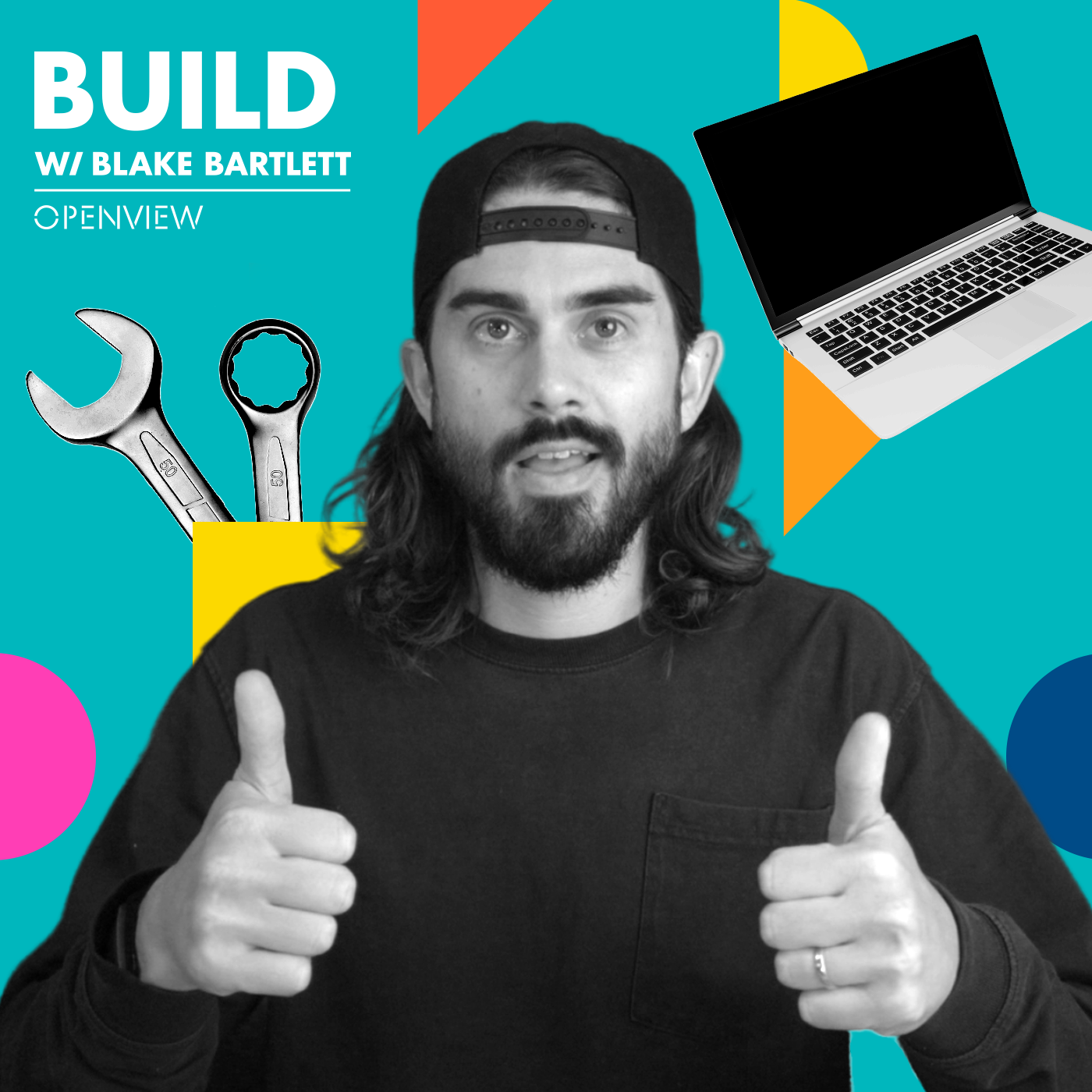
Blake Bartlett
Today's Guests

